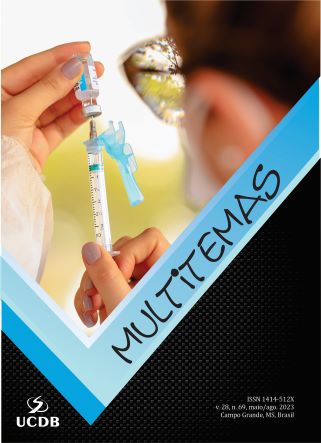Um estudo econométrico e de Machine Learning sobre indivíduos que se tornaram pobres na pandemia a partir da PNAD-Contínua
DOI:
https://doi.org/10.20435/multi.v28i69.4104Palavras-chave:
Econometria, pobreza, Machine LearningResumo
Este trabalho visa investigar a relação entre pobreza e a pandemia da covid-19, a partir de microdados da PNAD-Contínua. Para obter diferentes abordagens sobre o tema, foram utilizadas duas metodologias: 1) Econometria e 2) Aprendizado de Máquina (Machine Learning). O estudo tem como foco entender os principais determinantes da pobreza no período da pandemia, bem como prever a vulnerabilidade de indivíduos à pobreza utilizando Machine Learning. Os resultados obtidos apontam para uma maior chance de passagem para a pobreza em indivíduos não brancos, mulheres, moradores da região metropolitana, indivíduos em famílias maiores e com menor grau de instrução. Além disso, o algoritmo XGBoost obteve o melhor desempenho na previsão da pobreza após o balanceamento dos dados. Estes resultados podem ser utilizados para auxiliar na tomada de decisões no combate à pobreza no Brasil.
Referências
ATHEY, Susan; IMBENS, Guido. Machine Learning Methods That Economists Should Know About. Annual Review of Economics, [s.l.], v. 11, n. 1, p. 685–725, 2019.
CARUANA, Rich; NICULESCU-MIZIL, Alexandru. An Empirical Evaluation of Supervised Learning for ROC Area. In: INTERNATIONAL WORKSHOP, 1., Valencia, 2004. Valencia: ROCAI, 2004.
CHAKRABARTY, Navoneel; BISWAS, Sanket. A Statistical Approach to Adult Census Income Level Prediction. In: INTERNATIONAL CONFERENCE ON ADVANCES IN COMPUTING, 1., [s.l.], 2018. Proceedings […]. [s.l.]: IEEE, 2018.
CHEN, Li-Pang. Supervised Learning for Binary Classification on US Adult Income. Journal of Modeling and Optimization, [s.l.], v. 13, n. 2, p. 80-91, 2021.
FAYYAD, Usama; PIATETSKY-SHAPIRO, Gregory; SMYTH, Padhraic. From data mining to knowledge discovery in databases. AI Magazine, Washington, v. 17, n. 3, p. 37-54, 1996.
GONÇALVES, Solange Ledi; MACHADO, Ana Flávia. Poverty dynamics in Brazilian metropolitan areas: An analysis based on Hulme and Shepherd’s categorization (2002–2011). EconomiA, Niterói, v. 16, n. 3, p. 376-94, 2015.
LEE, Samuel; LEE, Edward. Fuzzy Sets and Neural Networks. Journal of Cybernetics, [s.l.], v. 4, n. 2, p. 83-103, 1974.
MARINHO, Emerson; MENDES, Sérgio. The impact of government income transfers on the Brazilian job market. Estudos Econômicos, São Paulo, v. 43, n. 1, p. 29-50, Jan./Mar. 2013
MASRI, Diala; FLAMINI Valentina; TOSCANI, Frederik. The Short-Term Impact of COVID-19 on Labor Markets, Poverty and Inequality in Brazil. International Moneraty Fund Working Paper [online], [s.l.], 2021.
OLIVEIRA, Gilson de; RAIHER, Augusta Pelinski. The inclusion of poor youth in the Brazilian labour market and the impact of the Bolsa Família programme. CEPAL Review, [s.l.], n. 135, 2021.
PARRAY, Irfan Ramzan; KHURANA, Surinder Singh; KUMAR, Munish; ALTALBE, Ali. Time series data analysis of stock price movement using machine learning techniques. Soft Computing, [s.l.], v. 24, p. 16509-517, 2020.
RIBEIRO, Jouse; SANTOLIN, Roberto. An evaluation of the structure of the labour market, assistance policies and sectoral productivity on the pro‐poor growth for Brazil from 2004 to 2014: a dynamic panel analysis. Journal of International Development, [s.l.], v. 33, n. 5, p. 927-44, 2021.
RIBEIRO, Lilian Lopes; MARINHO, Emerson. Time poverty in Brazil: measurement and analysis of its determinants. Estudos Econômicos, São Paulo, v. 42, n. 2, p. 285–306, 2012.
SCALON, Celi; CAETANO, André Junqueira; CHAVES, Hugo; COSTA, Luana. Back to the past: gains and losses in Brazilian society. The Journal of Chinese Sociology, [s.l.], v. 8, n. 3, 2021.
SMITH, Michael; MARTINEZ, Tony; GIRAUD-CARRIER, Christophe. An instance level analysis of data complexity. Machine learning, [s.l.], v. 95, n. 2, p. 225-56, 2014.
TOPIWALLA, Mohammed. Machine learning on UCI adult data set using various classifier algorithms and scaling up the accuracy using extreme gradient boosting. 2013. (Dissertation for Big data and Analytics) - University of SP Jain School of Global Management, Portland, 2013.
VARIAN, Hal. Big data: New tricks for econometrics. Journal of Economic Perspectives, [s.l.], v. 28, n. 2, p. 3-28, 2014.
VERDIKHA, Naufal Azmi; ADJI, Teguh Bharata; PERMANASARI, Adhistya Erna. Study of undersampling method: Instance hardness threshold with various estimators for hate speech classification. IJITEE, Yogyakarta, v. 2, n. 2, p. 39-44, 2018.
WANG, Hongchang; LI, Chunxiao; GU, Bin; MIN, Wei. Does AI-based credit scoring improve financial inclusion? Evidence from online payday lending. In: INTERNATIONAL CONFERENCE ON INFORMATION SYSTEMS, 40., 2019, Munich. Proceedings […]. ICIS: Munich, 2019.
WU, Xindong; KUMAR, Vipin; QUINLAN, Ross; GHOSH, Joydeep; YANG, Qiang; MOTODA, Hiroshi; MCLACHLAN, Geoffrey; NG, Angus; LIU, Bing; YU, Philip; ZHOU, Zhi-Hua; STEINBACH, Michael; HAND, David; STEINBERG, Dan. Top 10 algorithms in data mining. Knowledge and Information Systems, v. 14, n. 1, p. 1-37, 2007.
Downloads
Publicado
Como Citar
Edição
Seção
Licença
Copyright (c) 2023 Roberto Santolin, Patrick Gomes de Oliveira

Este trabalho está licenciado sob uma licença Creative Commons Attribution 4.0 International License.
Os artigos publicados na Revista Multitemas têm acesso aberto (Open Access) sob a licença Creative Commons Attribution, que permite uso, distribuição e reprodução em qualquer meio, sem restrições desde que o trabalho original seja corretamente citado.
Direitos Autorais para artigos publicados nesta revista são do autor, com direitos de primeira publicação para a revista. Em virtude de aparecerem nesta revista de acesso público, os artigos são de uso gratuito, com atribuições próprias, em aplicações educacionais e não-comerciais.


